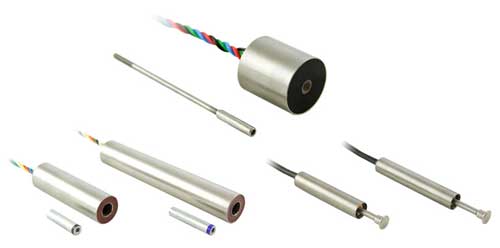What Are the Different Types of LVDTs?
Written by transtek_admin on 12/08/2023

LVDTs are versatile, yet relatively simple devices that are used in a wide variety of applications and industries to measure displacement. They are precision inductive sensors that are built around a simple yet very efficient design. LVDTs are made up of three components: a primary coil, two secondary coils wound coaxially around it, and a movable ferromagnetic core.
When an the primary coil is energized by voltage, it creates an electromagnetic field that the ferromagnetic core couples to the secondary coils. This coupling induces voltages in each secondary coil. The secondary coils are wired in series opposition, which means they produce AC voltages that are 180° out of phase with one another.
The magic of LVDT technology lies in how the core’s position directly influences the voltage magnitude in each secondary coil. As the core moves linearly within the coil assembly, it changes the magnetic coupling between the primary and each secondary coil, creating a measurable electrical output that corresponds precisely to the core’s displacement.
As such, there are different types of LVDTs available to accommodate their seemingly countless uses. This could be a long discussion, as we could classify LVDTs by operation, then by configuration, and separately, by application. In the interest of ever-shrinking attention spans, we’ll quickly tackle operation, then configuration and application together afterward.
AC vs DC LVDTs
AC LVDTs use an alternating current (AC) voltage to excite the primary coil, which creates a voltage difference in the secondary coils proportional to the displacement of the core. They’re known for their high accuracy and sensitivity. DC LVDTs are AC LVDTs with an oscillator/demodulator circuit added to allow for operation with DC voltage input. They can be more expensive and have a lower frequency response, but a DC analog output is generally easier to interface with.
Basic/Rod Style LVDTs
The most basic type of LVDT is a free-floating core unit, often referred to as a rod style LVDT. It consists of the housing and core, with an extension rod that is attached between the core and the moving part being measured. The core is not attached to either the primary or secondary coils, and its position between the coils determines the output voltage of the transformer. Rod type LVDTs are highly accurate and durable, provide a wide range of motion, and can withstand shock and vibration.
Spring Loaded LVDTs
Spring loaded LVDTs, often called gaging LVDTs, incorporate an internal spring mechanism that applies constant force to the core. In this case, the extension rod is more like a spring-loaded plunger that traps the core. Spring loaded LVDTs provide consistent contact, which leads to highly repeatable and accurate measurements. Also, they boast excellent sensitivity and accuracy since the spring reduces friction between the core and the housing. They are compact and durable since the spring allows them to absorb shock and vibration. One drawback is that the spring slows the frequency response of the LVDT.
These attributes, coupled and versatility, make spring-loaded LVDTs perfect for various gaging applications. With single-point gauging, the tip directly touches the object at a single point, which is ideal for measuring thickness, diameter, or runout. With multi-point gauging, multiple tips are arranged in a specific configuration, allowing for simultaneous measurement of complex shapes or profiles. Spring loaded LVDTs can also be used for force-limited gauging, where the spring pre-load can be adjusted to limit the force applied by the tip, protecting delicate surfaces from damage.
Trapped Core LVDTs
Unlike the rod style where the core moves freely, here, the core is contained within the housing, and doesn’t come out. The housing sleeve can slide back and forth along the transformer’s axis, but the core itself remains fixed within it. On the plus side, they are compact, relatively stable, and provide frictionless operation. However, if the rod or core breaks, they can’t be replaced. All the components are enclosed as one assembly, limiting reparability. As a result, they aren’t as popular as other configurations, but do have their place for certain applications such as precision instruments in the medical and research fields.
Need Help Determining Which LVDT is best for your application?
Contact us today, we’re happy to help.

